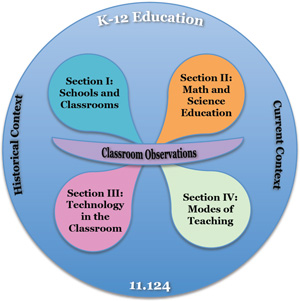In this section, Prof. Klopfer describes how he sequenced the course topics and how the course’s final assignment, a course portfolio, helped students connect the topics together.

In order to construct the Final Portfolio, students connect all the course units together while pulling in their personal experiences from both in and out of the class. (Image courtesy of Jane He.)
Creating the Course Syllabus
Choosing the topics for the course was easier than choosing the order of the topics. There were certain ideas that we needed our students to take away from the class, so it wasn’t too hard to decide which topics we hit. Our major topics were schools and classrooms, math and science education, technology in the classroom, and modes of teaching.
Deciding the order in which we taught those topics was a bit more challenging. As instructors, we always try to sequence topics in a way that makes sense as you look at the arc of the materials for the entire course. Often times, the sequence makes sense to us, but the students tend to see each of the units as individually useful; they don’t easily see the arc that links all the course units together.
Helping Students See the Big Picture
To direct our students towards seeing the big picture in this class, we introduced the final assignment: crafting a course portfolio. While creating the portfolio, students are required to reflect upon topics and experiences from the entire duration of the course and piece together what happened during the semester. This is a prime example of our constructivist approach and a great way to help the students think through, “This is what happened over the course of the year, this is how it makes sense, and now everything kind of comes together.”










